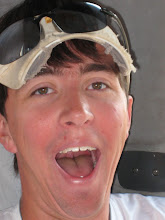
The tome og King Herod at Herodium.

Jericho supporting walls.

Me at the wilderness viewpoint.

Day 5 was probably the craziest day so far. It took 12 and a half hours to go from hotel back to hotel. I took 140 pictures and I don't like to take pictures. We started by going to the Mount of Olives. Here we looked at a new angle of Jerusalem and discussed the topography and what areas we could see. While on the Mount of Olives we went down to another good view point this time at a church which marked the place where Jesus wept. At this same location we found estuaries dating back to Jesus' time. An estuary is a box that is as wide as the widest bone of the body, the skull, and as long as the longest, the femur (thigh-bone). While still on the Mount of Olives we descended a little further to the Garden of Gathsemene. We saw olive trees which would have been similar to the trees Jesus was near. THe location may not have been exactly right but it was near. Ther is a Catholic Church at this location which marks the stone where Jesus prayed to the Father right before he was arrested. Once again I think that the churches that are built upon these locations for one makes it difficult to know because it prevents the search for archeaological evidence, two they make shrine and idols out of them which pervert the weight of the sight and make it into a side show.
After the Mount of Olives we hopped onto a bus and drove to Herodium, a fortress and Palace of King Herod. It was an interesting site which gave a good view of Bethlehem and Tekoa, the home of Amos for those who remember the minor prophet. Also at this site was the tomb of Herod which is a very important archaeological site.
Following Herodium we went to Bethlehem. Here we stopped at the traditional location of Jesus' birht. At this site was built a Greek Orthodox and Catholic church. The cave at which Jesus was born has a star at the exact location. I think this very well could be the actual place, because of a very early tradition, but once again they have, in my mind, ruined the location by turning into a shrine. When you enter it feels nothing like a cave or a place Jesus was born but instead like some legalistic ritual that can clear away sin. The thing I found more interesting at the site was the cave in which the Christian Theologian Jerome lived and wrote. It was here that he learned Hebrew so he could translate the Bible into Latin.
After Bethlehem we went up into the hills just south of it to fine Solomon's Pools, which were really reservoirs built by King Herod to bring water to Jerusalem through aqueducts. They were impressive in size but not entirely relevant to the Bible.
After Jerusalem we stopped at another viewpoint south of Jerusalem for some pictures but quickly moved on to Jericho. At Jericho we saw the Tel (a location where a city was built then destroyed, then another city, and so on creating a large mound) which was formerly Jericho. We saw teh supporting wall for the city walls. Then we saw an ancient Tower dating to 6000 BC. Also in the excavations we found a pot burned, just as Joshua said they did to the city after the walls fell. The pots like this that they found had grain in them showing that it was likey at harvest time, matching the Bible, and that it was not a long siege, also mathcing the Biblical story. Also in jericho we went and looked at the remains of one of Herod's palace. It was massive strecthing from one side of a kilt (canyon or valley with steep sides) with a bridge that would have connected them. This was his favorite palace according to historical sources.
Following Jericho we drove up to a viewpoint of the wilderness of Judah. It was beautiful especially with the sun setting at the time.




No comments:
Post a Comment